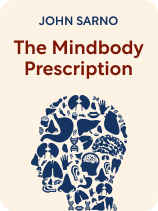

This article is an excerpt from the Shortform book guide to "The Mindbody Prescription" by John Sarno. Shortform has the world's best summaries and analyses of books you should be reading.
Like this article? Sign up for a free trial here.
What do emotional repression symptoms look like? How can you tell if your emotions are repressed?
Emotional repression symptoms often include physical signs like pain and tension in the body. By knowing what this looks like, you can learn to recognize and address your unconscious emotions.
Read on to learn how repressed emotions affect the body and how to recognize when this is happening.
Conscious and Unconscious Emotions
When trying to understand emotional repression symptoms, you need to understand the distinction between the conscious and the unconscious. The conscious is the part of our mind that we’re aware of: It’s logical, rational, mature, controlled, moral, and confident. The unconscious is the part of our mind that we’re unaware of: It’s irrational, childish, uncontrolled, lacks morals, and has low self-esteem.
The emotions we’re conscious of are our perceived emotions. However, many of our emotions are unconscious, or repressed. These are the emotions that come from the child—and more specifically, from the conflict between the parent and the child. We’re not aware of them, but they heavily influence our lives, behavior, and even our physical state. In particular, our perceived (conscious) emotions may increase pain we’re already feeling, but I’m repressed emotions can cause pain.
| The Unconscious: The Source of All of Our Problems? Other writers suggest a similarly impactful role of repressed emotions. In Existential Kink, Carolyn Elliott argues that our repressed emotions are so powerful that they’re responsible for creating all the negative behaviors and patterns in our lives. Even though we outwardly desire positive things—like success, independence, and connection—our unconscious desires both positive and negative things—such as failure, dependence, and loneliness. As with the child-like emotions, we repress these desires, but they continue to manifest in our behavior. According to Elliott, this is why someone might be stuck in a negative pattern like only getting into relationships with controlling partners. Their conscious desires freedom, but their unconscious desires dependence and containment, so the unconscious drives that person to behave in ways that attract controlling partners and repel healthy partners. In the same way, no one consciously wants to experience physical pain, but our repressed emotions must make themselves known in some way—so the unconscious creates pain. |
Which Emotions Do We Repress?
The emotions we repress tend to be considered negative ones, often associated with the undesirable tendencies of the child. These include shame, sadness, and especially anger. Sarno explains that we repress these emotions because we’re uncomfortable with them, so on a psychological level, we can’t stand to process or acknowledge them.
We’re often particularly uncomfortable with emotions that aren’t considered socially acceptable. For example, a person who’s recently lost a loved one may feel angry at that loved one for dying. This is a natural emotional reaction characteristic of the irrational child, but expressing this emotion outwardly would be considered wrong. Thus, that person represses that anger because it’s intolerable to them.
(Shortform note: This explains which emotions we repress and why, but this doesn’t address how we learn to repress them. Experts suggest that it has to do with our home environment: We learn how to deal with our emotions from our families. In particular, research suggests that there are three major ways we learn how to deal with our emotions from our parents: 1) how our parents react to our emotions, 2) how our parents discuss emotions, and 3) how our parents express their own emotions. When parents teach us that we can and should control our emotions (for example, by telling us to stop feeling a certain way or by hiding their own emotions), we learn to “control” our undesirable emotions by repressing them.)
Why Do Repressed Emotions Cause Physical Pain?
This brings us to the physical manifestations of repressed emotions: Because these emotions are intolerable to the conscious mind, the mind goes to great lengths to avoid acknowledging them. It distracts itself from them by forcing the person to focus on what’s going on in their body instead of what’s going on in their head, leading to physical symptoms like pain.
The mind chooses physical symptoms because, unlike emotional distress, physical conditions are socially acceptable. As diagnoses for a physical condition increase, doctors treat it as more “real,” which validates it as a socially acceptable condition. This is why chronic pain diagnoses change over time according to what’s popular (despite the root cause being emotional distress).
(Shortform note: The social stigma against emotional distress is widespread: Research suggests that a majority of Americans have negative attitudes toward mental illness. This can lead to stereotyping of mentally ill people as well as prejudice and discrimination against them. For example, only a small minority of states have legislation requiring schools to excuse student absences for mental health reasons. People with mental illnesses often internalize this social stigma, which can cause them to hold negative views about themselves and their emotions. These views make it even harder to deal with negative emotions, causing a destructive cycle.)
In the past, the psychosomatic illness tension myotisis syndrome (TMS) has commonly manifested as gastric ulcers, but the rate of ulcers declined over the past few decades. According to some experts, this is because people began to realize they were caused by stress, which delegitimized them in the public eye. To continue functioning as a socially acceptable distraction from emotional issues, our unconscious minds had to replace ulcers with other physical symptoms, which is when the epidemic of neck, back, leg, and shoulder pain arose. (Shortform note: Some research suggests that the development of ulcers may be more physiological than this implies. Stress can cause ulcers, but the gut is linked to the brain in a way that muscles aren’t: Not only does the brain send emotional signals to the gut, but the gut also sends emotional signals to the brain through the vagus nerve. Additionally, stress can affect the bacteria in the gut—potentially causing an increase in the growth of certain bacteria that can cause ulcers. This means such ulcers are physiologically (rather than psychologically) induced. These differences suggest that TMS and ulcers may not be equivalent.)

———End of Preview———
Like what you just read? Read the rest of the world's best book summary and analysis of John Sarno's "The Mindbody Prescription" at Shortform.
Here's what you'll find in our full The Mindbody Prescription summary:
- A look at the chronic pain epidemic that's plaguing the Western world
- That the key to solving your pain is resolving your emotional tensions
- Why modern medicine doesn't recognize mindbody connection






